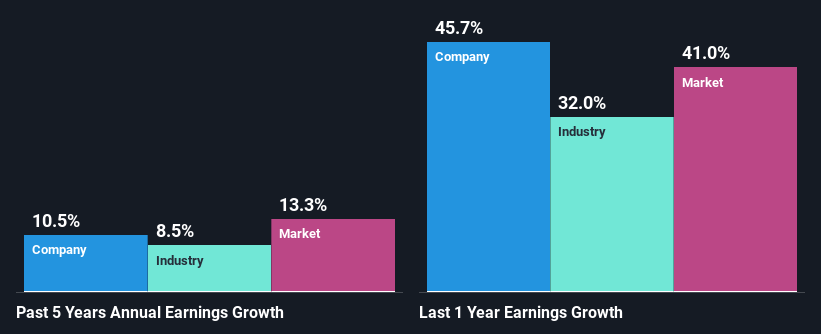Oshkosh Corporation's (NYSE:OSK) Stock Has Fared Decently: Is the Market Following Strong Financials?
Oshkosh's (NYSE:OSK) stock is up by 4.4% over the past month. Since the market usually pay for a company’s long-term financial health, we decided to study the company’s fundamentals to see if they could be influencing the market. Particularly, we will be paying attention to Oshkosh's ROE today.
Return on equity or ROE is an important factor to be considered by a shareholder because it tells them how effectively their capital is being reinvested. In simpler terms, it measures the profitability of a company in relation to shareholder's equity.
View our latest analysis for Oshkosh
How Do You Calculate Return On Equity?
The formula for return on equity is:
Return on Equity = Net Profit (from continuing operations) ÷ Shareholders' Equity
So, based on the above formula, the ROE for Oshkosh is:
15% = US$473m ÷ US$3.2b (Based on the trailing twelve months to September 2021).
The 'return' is the amount earned after tax over the last twelve months. Another way to think of that is that for every $1 worth of equity, the company was able to earn $0.15 in profit.
What Has ROE Got To Do With Earnings Growth?
Thus far, we have learned that ROE measures how efficiently a company is generating its profits. Depending on how much of these profits the company reinvests or "retains", and how effectively it does so, we are then able to assess a company’s earnings growth potential. Assuming all else is equal, companies that have both a higher return on equity and higher profit retention are usually the ones that have a higher growth rate when compared to companies that don't have the same features.
Oshkosh's Earnings Growth And 15% ROE
To start with, Oshkosh's ROE looks acceptable. Further, the company's ROE is similar to the industry average of 13%. Consequently, this likely laid the ground for the decent growth of 10% seen over the past five years by Oshkosh.
Next, on comparing with the industry net income growth, we found that Oshkosh's growth is quite high when compared to the industry average growth of 8.5% in the same period, which is great to see.
Earnings growth is an important metric to consider when valuing a stock. What investors need to determine next is if the expected earnings growth, or the lack of it, is already built into the share price. By doing so, they will have an idea if the stock is headed into clear blue waters or if swampy waters await. Has the market priced in the future outlook for OSK? You can find out in our latest intrinsic value infographic research report.
Is Oshkosh Efficiently Re-investing Its Profits?
Oshkosh's three-year median payout ratio to shareholders is 16% (implying that it retains 84% of its income), which is on the lower side, so it seems like the management is reinvesting profits heavily to grow its business.
Additionally, Oshkosh has paid dividends over a period of eight years which means that the company is pretty serious about sharing its profits with shareholders. Our latest analyst data shows that the future payout ratio of the company over the next three years is expected to be approximately 17%. As a result, Oshkosh's ROE is not expected to change by much either, which we inferred from the analyst estimate of 16% for future ROE.
Summary
In total, we are pretty happy with Oshkosh's performance. Particularly, we like that the company is reinvesting heavily into its business, and at a high rate of return. Unsurprisingly, this has led to an impressive earnings growth. The latest industry analyst forecasts show that the company is expected to maintain its current growth rate. To know more about the company's future earnings growth forecasts take a look at this free report on analyst forecasts for the company to find out more.
This article by Simply Wall St is general in nature. We provide commentary based on historical data and analyst forecasts only using an unbiased methodology and our articles are not intended to be financial advice. It does not constitute a recommendation to buy or sell any stock, and does not take account of your objectives, or your financial situation. We aim to bring you long-term focused analysis driven by fundamental data. Note that our analysis may not factor in the latest price-sensitive company announcements or qualitative material. Simply Wall St has no position in any stocks mentioned.
Have feedback on this article? Concerned about the content? Get in touch with us directly. Alternatively, email editorial-team (at) simplywallst.com.

